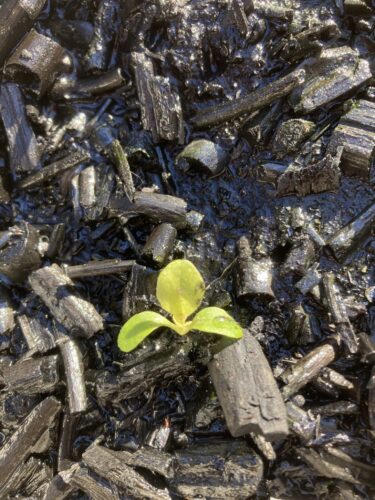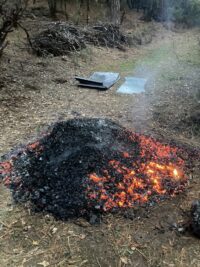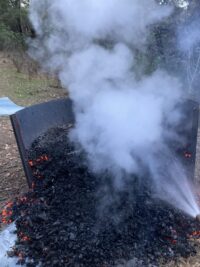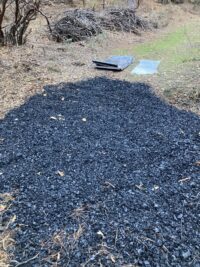This article was written by guest author C. Tabor Teachout from the BioChar Coalition in North San Juan, California.
BIOCHAR – Reduce Fire Threat While Increasing Forest Resilience
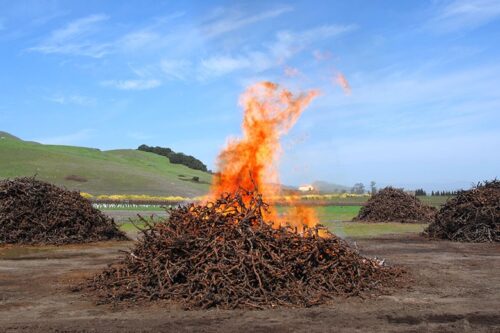


A conservation burn. photo Credited to Wines and Vines
In the landscape of our community, we are surrounded by overgrowth which, left unmanaged, could lead to a catastrophic wild fire in our back yard. Wood chipping and mastication services are tactics that are energy intensive and expensive and can’t be done everywhere. Standard burn piles that use much less energy, however, emit a lot of smoke pollution in our environment and leave behind only ash, of little value. In this article, I will describe how to conduct a pyrolysis burn which emits very little smoke and creates a ton of biochar, which, on the contrary, has tremendous value. It will be worth making biochar on your next safe burn day, and I will explain how using three options – Pyre, Pit, and Kiln. To find out legal burn day status check myairdistrict.com
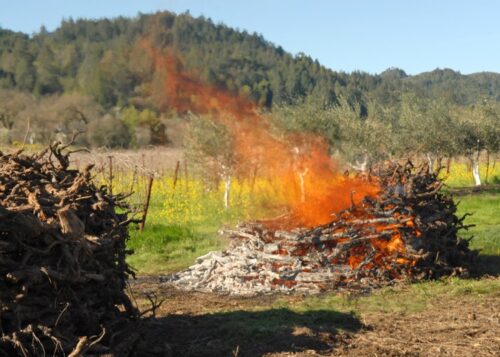


www.sonomabiocharinitiative.org/about-biochar/
For generations, California abandoned annual indigenous cultural fire practices. This subject actually deserves much more discussion with its own article. That being said, prescribed and cultural burns are low to the ground, slow moving, cool burns used to manage annual vegetative growth. Effective treatment will leave the ground covered with a thin layer of biochar along with some ash. Unfortunately, due to the long absence of that practice, it can no longer be safely used widely – yet. Instead, we manually gather dead and overgrown understory native and invasive plant species to reduce the volatile ladder fuel threats on lands not yet consumed by uncontrolled wild fires. Fire is not the problem; it’s a tool industrial societies have forgotten how to properly use. Unmanaged growth has become a problem, therefore, needing intervention of more brush clearing work before we can return to widespread controlled burns for maintenance. Biocharma.com is developing a service to help convert biomass into biochar where it is. Sheep can also be an effective tool for helping convert overgrowth into soil fertility and incorporates well with biochar, also as an inoculation strategy.
Making Biochar adds great values:
- Less biomass = reduced fire threat
- Reduced smoke = less pollution
- Quenching eliminates wind spreading fire days later = reduced fire threat
- Filtering water = cleaner streams and rivers
- Increases soil porosity = more moisture and air in soils
- Water and nutrient attracting = enriches soil life’s nutrient availability
- Soil moisture retention = improves drought and fire resilience
- Sequestering Carbon removed from the atmospheric cycle = climate benefits
- Carbon that won’t decompose = Stable Climate benefits
- Beneficial for livestock ingestion and bedding = improves livestock health & well being
- plus many more uses this article won’t attempt to cover…
There are multiple options for how to make biochar. The easiest strategy – I call a Pyre – consists of creating an above ground pile of biomass. If the fire is started at the bottom, as is common, the flame will climb into the pile and cause a lot of smoke to start bellowing until the flame is able to consume the pile, leaving behind only ash. If, however, we learn to practice igniting a fire on top, the flame will develop quickly to consume any smoke. Do Not use any flammable liquid fuel to start a pyre! Do Not add any more biomass once pyre is lit! If any more material gets added, it will not be capable of becoming biochar by the time all the biochar first created in the pyre will have burned down and becomes ash. Our goal is to increase the amount of biochar created and reduce the amount of smoke and ash.
Burning biomass to ash is creating more pollution. One quarter of all biomass is formed from carbon in the cell walls. If allowed to burn completely to ash, it would add to the global atmospheric carbon saturation. When burning, as described in this article, 20% of the biomass is saved as stable crystalized carbon which we then sequester into our land. This, then, helps soil retain moisture for gardens, orchards, and forest health.
How to make biochar in a Pyre:
- Pile biomass where it is safe to burn.
- Ignite a fire on the TOP of pile. No liquid fuels!
- Don’t add more biomass once lit.
- Wait while fire burns down and until flame is out.
- If burning in a pit or kiln, more biomass could now be added.
- Wait again for flame to be out
- Quench gently with water.
The red hot coals will become cool black biochar.
Discover more photos at www.biocharcoalition.org/photos/
To increase efficiency, a pit can be dug up to 5 feet deep and 6.5 feet wide. These pits are commonly dug into a cone shape. Flame Cap Kilns offer a safe container for an above ground fire and work as effectively as a pit. In both cases, a pyre is how it starts, filling the kiln or pit with biomass and igniting on top. Once the flame burns out settling into a layer of red hot coals, in an above ground pyre, it would be time to quench. In a pit or kiln, however, more biomass can then be added regaining flame. If biomass is added too soon, the material on the bottom may not complete burn before its suffocated by the accumulating additional char. As long as the flames are covering the surface of the kiln/pit, oxygen gets consumed creating a pyrolysis reaction leaving the carbon to settle to the bottom without oxygen. Biomass can be continually added until the kiln/pit are full of char or the available biomass is consumed.
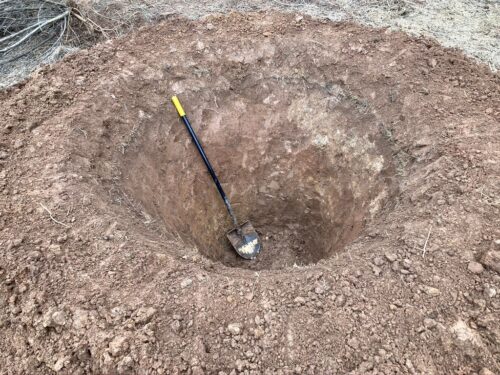


My first flame cap kiln was a 55 gallon barrel, however its not a burn barrel which is illegal to use. The reason burn barrels are banned is because they have holes on the bottom and lower sides that increase oxygen flow into the barrel causing ash and sparks to be able to blow out and spread fires. Using a barrel with no side nor bottom holes, the only opening on top, can be used as a kiln. I now use a Ring of Fire biochar kiln (from WilsonBiochar.com) which has a larger chamber to handle greater length biomass and a larger volume of biochar can be completed per burn. I do keep my barrel handy to put in any uncompleted char logs found on the bottom in the biochar pile, allowing it to finish burning while I quench the rest of the completed biochar. One person can feed multiple kilns or pits at a time creating one to one and a half tons of biochar per day!
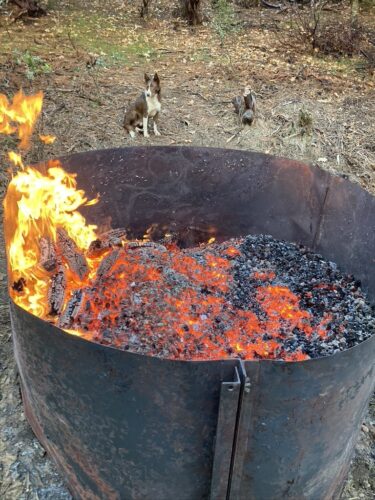


This is the time of year we have a limited opportunity to burn our overgrown fire threatening biomass within our community. Biomass is reduced 80% when making biochar. Becoming porous, hollow carbon cell structures are capable of holding 2.7 times their mass in water and nutrients, equivalent to 3 gallons of water per pound. Biochar is 95% stable carbon and 5% minerals that would have become ash. Spreading the biochar across our landscapes along keylines and in drainage ditches will slow the flow of water and sediment across our land while holding on to nutrient run off. Biochar behaves as a filter and the carbon molecules have a negative polarity, attracting all other elements to bond with it.
Nutrient empty fresh biochar can be well inoculated by layering under, within and/or on top of your compost piles. Spreading around any livestock activity will inoculate the biochar with nutrients including absorbing methane and odors from manures and decomposition. Perhaps the quickest and easiest way to incorporate valuable nutrients including nitrogen is to simply pee on a dry pile of biochar. Inoculation before incorporating into a garden bed is highly recommended. (KOFrass.com has more inoculation strategies deserving another article.) Wherever I spread out the black layer of char, I try to also cover it with a layer of wood chips to reduce any solar heat absorption that could also dry out the Biochar. This also encourages mycelium to incorporate into the char. If no intentional inoculation is done, time will take care of it.
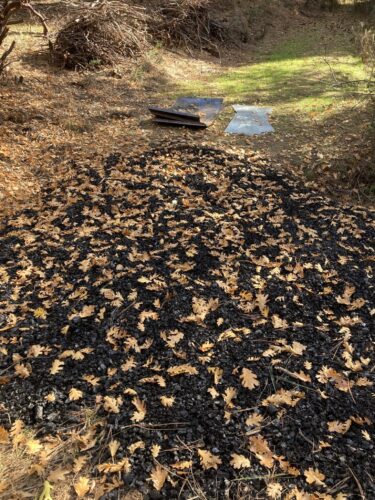


I have been utilizing a growing flock of sheep to help manage the increasing overgrowth we annually have needing management. Utilizing electric or metal fence systems, I move my flocks of sheep year round, hiring them out to properties where masticators and chippers have previously been or can not safely go. Some land owners simply prefer to see and hear the sheep add fertility while they are there. A few mastication services have recommended to use ForageService.com to help manage the regrowth that can follow their soil disturbance. When the sheep are on neglected lands, I help cut and pull tall brush to help the sheep reach more to eat. The biomass that we have been clearing is arranged in preparation for burning into biochar when a burn day is available. When the sheep return to eat regrowth, they help trample the biochar into the ground and add more urine and manure, developing a layer of rich soil. When the sheep have access to fresh biochar, their lips get blackened from eating it. This process can help keep a healthy gut by absorbing toxins and pathogens. Fresh clean biochar is also safe for human consumption.
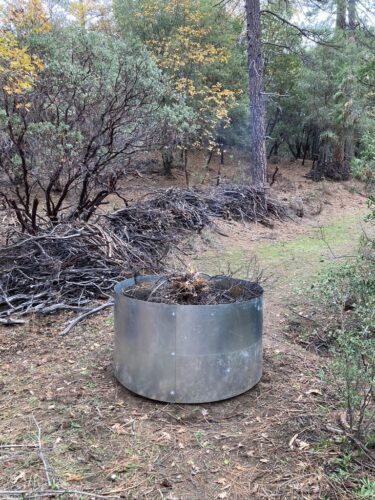


Rediscovered soils created by ancient people over two thousand years ago are 50% biochar varying from 1.6 feet to 6.5 feet top soil depth and are the richest, still highly productive top soils in the world. We live amongst a bounty of biomass needing management which we could be enriching our soils with now and for the future by practicing making more biochar!
Check out Tabor’s youtube channel ->
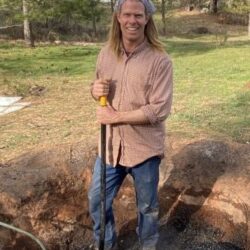


C Tabor Teachout
Living for the past 20+ years in the forest on the San Juan ridge, a Shepard and biochar advocate. Reading Terra Preta by Kathleen Draper created a biochar passion, her next book Burn is another excellent biochar doctrine. Please join the movement, make more biochar!
Find out more about biochar by checking out our website at:
